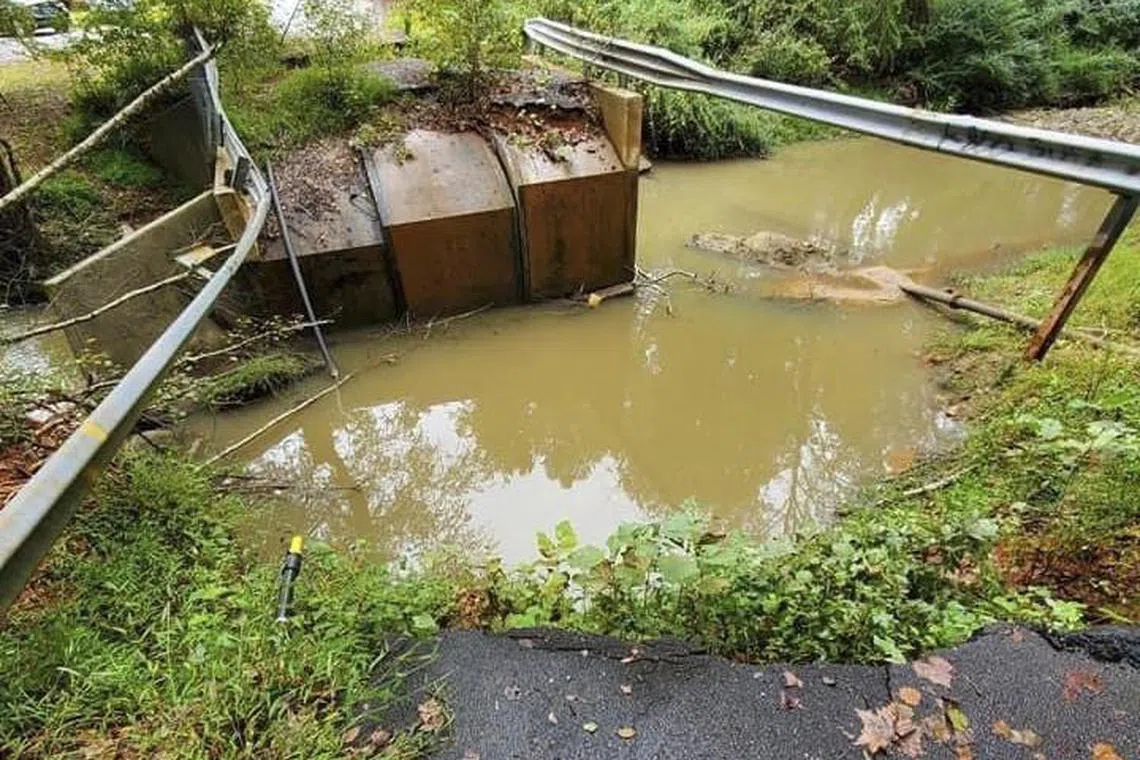US family blames Google Maps for man who drove off collapsed bridge and died
Sign up now: Get ST's newsletters delivered to your inbox

An undated family photo shows Mr Philip Paxson, 47, with his wife, Alicia, and their daughters.
PHOTO: NYTIMES
Follow topic:
NORTH CAROLINA – The family of a North Carolina man who drowned in 2022 after he drove off a collapsed bridge while following Google Maps directions has sued Google for negligence.
They say the company’s failure to update its maps led directly to his death.
Mr Philip Paxson, 47, a medical device salesman, was on his way home from his daughter’s camping-themed ninth birthday party in Hickory, North Carolina, on Sept 30, 2022.
He was navigating unfamiliar roads on a rainy night when he drove off a collapsed roadway into a creek and drowned, according to the lawsuit, which was filed in Wake County Superior Court on Tuesday.
Mrs Alicia Paxson, his wife, also sued two businesses and an individual who the lawsuit says owned, controlled or were responsible for the collapsed bridge, which was unmarked, with no barricades.
Mrs Paxson had taken their two daughters home from the party in her car, while her husband stayed late to clean up and drove separately, she said in an interview.
“This is horrific, what our family is going through,” she said.
When she thinks about how easily it could have been prevented, given that people had warned Google about the dangerous route it was suggesting, “it just kills me”, she said.
Mrs Paxson said she searched her husband’s phone after the accident and found that he had looked up directions home from the party on Google Maps.
A Google spokesman, Mr Jose Castaneda, said in a statement that the company, which is owned by Alphabet, had the deepest sympathies for the Paxson family.
“Our goal is to provide accurate routing information in Maps, and we are reviewing this lawsuit,” he said.
Google Maps has for years directed drivers to cross the bridge, which collapsed in 2013, according to the lawsuit.

Google Maps has for years directed drivers to cross the bridge, which collapsed in 2013, according to the lawsuit.
PHOTO: NYTIMES
In November 2020, Google Maps acknowledged receipt of a complaint submitted by a Hickory resident about the dangerous route recommendation.
However, the lawsuit said, it continued to suggest the route.
“This was a crater literally in the middle of a residential neighbourhood,” said Mr Robert Zimmerman, a lawyer for Mrs Paxson. “It’d be one thing if it was there for a day or a week, but it was there for nine years.”
Nearly a year after Mr Paxson’s death, Mr Zimmerman said, the bridge has not been repaired, and Google Maps is still directing drivers to cross it.
Google and the other defendants – Hinckley Gauvain LLC, Tarde LLC, and Mr James Tarlton, who, according to state records, owns Tarde – will be served with the lawsuit paperwork in the coming weeks, Mr Zimmerman said.
The companies and Mr Tarlton could not immediately be reached, and it was not clear if they had legal representation.
Mr Zimmerman said there was no valid reason for the firms and Mr Tarlton, who were responsible for maintaining the bridge, to have left it in such a dangerous state for so long, with no barricades, warning signs or lighting around it.
A spokesperson for the North Carolina Department of Transportation said in an e-mail on Thursday that “the section of road where this incident occurred is owned by a private entity” and that the department “has no legal authority to make improvements to this location”.
The lawsuit said Google Maps and other mapping and navigation platforms had the responsibility to update their maps in a timely manner and to correct routes once they were notified of hazards.
The lawsuit raises a question for GPS developers: Who is liable when injuries or fatalities occur because of faulty directions?
The question has become particularly relevant for Google Maps, the most popular mapping service in the United States.
In 2018, 72 per cent of smartphone users looked up directions on Google Maps, according to market insight company Statista.
The next most popular app was Google-owned Waze, which was used by 12 per cent of smartphone owners that year.
GPS services have come under criticism not just for directing drivers through hazardous routes but also for disorienting hikers.
Mountaineering Scotland, a climbing organisation, and the John Muir Trust, a charity that maintains natural areas in Britain, have warned that Google Maps may direct hikers to trails that would lead them over cliffs and rocky, steep terrain. NYTIMES

